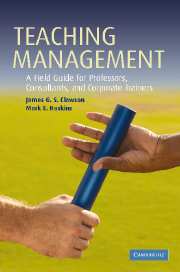Book contents
- Frontmatter
- Contents
- List of figures
- Sources to chapter quotations
- Why this book on teaching management?
- 1 Fundamental elements in teaching
- 2 Levels of learning: one, two, and three
- 3 Adult learning theory: it matters
- 4 Planning a course: trips and tips
- 5 Planning a class: no detail is too small
- 6 Lecturing: the possibilities and the perils
- 7 Managing discussions
- 8 Case method: fostering multidimensional learning
- 9 Role-playing
- 10 Case writing: crafting a vehicle of interest and impact
- 11 Case teaching notes: getting from here to there
- 12 Action learning
- 13 Experiential methods
- 14 Enhancing the conversation: audiovisual tools and techniques
- 15 Executive education: contributing to organizational competitive advantage
- 16 Using technology to teach management
- 17 Counseling students
- 18 Evaluating students: the twin tasks of certification and development
- 19 Teaching evaluations: feedback that can help and hurt
- 20 Research presentations
- 21 Managing a degree program: behind the ‘glory’
- 22 Managing a nondegree client program: an overview
- 23 Dealing with the press
- 24 Managing yourself and your time
- 25 Using teaching portfolios and course portfolios
- 26 Conclusion: is this on the exam?
- Index
23 - Dealing with the press
Published online by Cambridge University Press: 25 February 2010
- Frontmatter
- Contents
- List of figures
- Sources to chapter quotations
- Why this book on teaching management?
- 1 Fundamental elements in teaching
- 2 Levels of learning: one, two, and three
- 3 Adult learning theory: it matters
- 4 Planning a course: trips and tips
- 5 Planning a class: no detail is too small
- 6 Lecturing: the possibilities and the perils
- 7 Managing discussions
- 8 Case method: fostering multidimensional learning
- 9 Role-playing
- 10 Case writing: crafting a vehicle of interest and impact
- 11 Case teaching notes: getting from here to there
- 12 Action learning
- 13 Experiential methods
- 14 Enhancing the conversation: audiovisual tools and techniques
- 15 Executive education: contributing to organizational competitive advantage
- 16 Using technology to teach management
- 17 Counseling students
- 18 Evaluating students: the twin tasks of certification and development
- 19 Teaching evaluations: feedback that can help and hurt
- 20 Research presentations
- 21 Managing a degree program: behind the ‘glory’
- 22 Managing a nondegree client program: an overview
- 23 Dealing with the press
- 24 Managing yourself and your time
- 25 Using teaching portfolios and course portfolios
- 26 Conclusion: is this on the exam?
- Index
Summary
I am unable to understand how a man of honor could take a newspaper in his hands without a shudder of disgust.
– Charles BaudelaireIt may be a bit surprising to find a chapter on dealing with the press in a book on teaching business management. As it turns out, though, business management instructors are confronted with a surprising number of opportunities to speak with the press. Journalists of all kinds, newspaper, magazine, and freelance, are likely to call one day, sooner than you might expect, to ask your opinion about any number of broad topics that they heard somewhere that you had special expertise in. This chapter will present some ideas that may help you deal with these opportunities.
Press contacts usually happen in one of three ways: cold calls, referral calls, and publication follow-ups. In cold calls, an instructor gets a phone call out of the blue and is asked some questions about events taking place in the world or a particular topic on which the writer is developing an article. It may not be you in particular whom they are calling, rather it may be they are simply seeking someone at your company or university who can give them some good insight or pithy quotes.
Referrals typically come from colleagues or from your organization's public relations department. University or corporate press relations offices keep contact with various new wire services in their regions so that when an academic or corporate opinion is called for, the reporter may call the press office which will then refer the writer.
- Type
- Chapter
- Information
- Teaching ManagementA Field Guide for Professors, Consultants, and Corporate Trainers, pp. 449 - 453Publisher: Cambridge University PressPrint publication year: 2006

